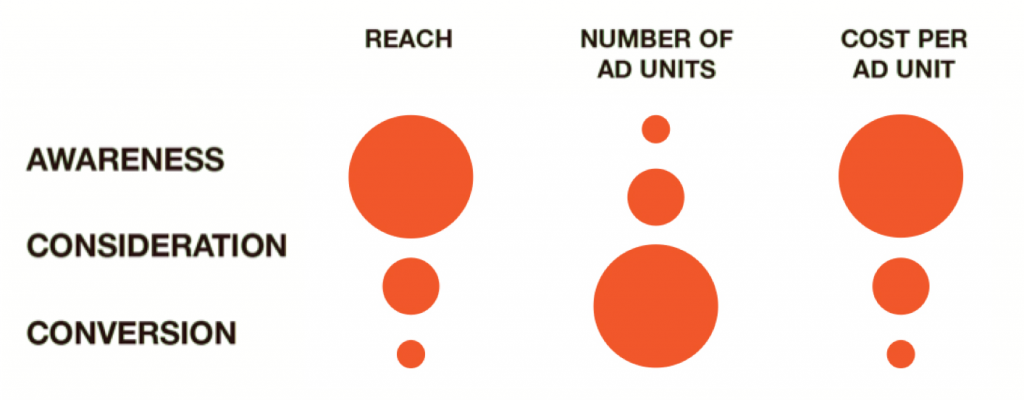
In 1994, the success of Dumb & Dumber (Box office close to 250M USD) had a lot to do with the performance of Jim Carrey. In that same year, John Travolta made an iconic comeback role from a career slump with his iconic portrayal of Vincent Vega in Pulp Fiction (box office 220M). I think it would be safe to say that although each played their respective roles with great aptitude, they could not have switched roles and performed as well.
An even less feasible idea would be to have one of them play both roles, not to mention the idea of having one of them take on ALL roles in both productions, from lead actor to lighting assistant. Yet that is how we often look at innovation and new technology. On one side the evangelists, claiming AI/AR/Voice/Chatbots will revolutionize every aspect of marketing. On the other side the sceptics, who say this is not feasible and therefore dismiss the new thing in its entirety.
As with actors, a lot of tools within marketing can work fine in one role but be lost in another. This is true of classic campaigning (an emotional 45 second TV ad is great at driving brand but poor at driving short term conversion, DM or SEM is the opposite). It is also very true when it comes to innovation.

Over 10 000 Google hits for stuff that will change marketing forever
I would argue that innovative techniques, platforms and tools can be very useful, as long as you are careful in what role you cast them. Of course, this all relates back to the principles of strategy vs tactics. “Look at the script before to assign an actor to a role” is easily translated to “look at your strategy before implementing tactical activities”. (See JP Hanson , Mark Ritson among others).
So, what are the potential (tactical) roles for innovation? On an overall level, I see a handful;
Advertising distribution channels
A very clear and concise role; Getting your message in front of consumers in efficient and effective manner. This is an area where innovation is discussed a lot, AI supported programmatic buying, new social media targeting opportunities and formats, as well as influencer marketing being topics du jour. A few words of caution
- The new innovation happening within media channels has an impact primarily in tactical communications, rather than broad reach channels. Don’t confuse the two, as Pepsi did in 2010 when they shifted millions in TV spend to a Facebook Social Good project, loosing half a billions worth in market share to coke.
- New channels need to have some sort of reach and need to supply relevant ad formats in order to be a significant part of media strategy. (No, Smart Speakers is not a Distribution channel strategy. Skip down to Storytelling instead
Creative fuel / Storytelling
This is an interesting segment, and something often overlooked by the sceptics. Even if a new shiny thing has no potential impact on the overall business, the media or the customer experience, it may be useful as a tool to tell a story. Look at how Amazon have used drone deliveries and stores without checkout to promote their image of them as driving the future of retail. A recent example from Sweden features a direct heating company using AI and smart speakers to talk about heating and human warmth.
While this involves new tech, the message is distributed through old fashioner PR, TV and online video, so no media innovation. The effort does not really involve product or user experience innovation. It is just an innovative way to tell a story. Which is not a bad thing!
(Just look at Volkswagens’ use of (very basic) door lock technology from “The Force” to tell a story about creating nice cars that fit family needs.)
Another curiosity, which has perhaps not generated anything really significant yet, is the AI creative director. Both McCann
and Lexus have tried it, and it seems to render either fairly generic or fairly crazy stuff.
Product and business development

Of course, new technologies can disrupt industries and improve products, or render them obsolete. The classic case in this field is photographic film company Eastman Kodak, who went from peak at 31 billion USD value in 1996 to filing for bankruptcy in 2012. However, this is a rare and extreme case, too often taken as proof that all companies must “innovate or die”. Also, Kodak showcases a need to innovate core product offering. That does not automatically mean they needed to innovate their creative or media strategies.
CX/UX
IKEA Place. Actually useful AR, rather than just PR content.
Another interesting field is the ecosystem surrounding a product and service, the users’ interface: support and customer service, user guides and inspiration, all things aiming to make using the product a delight.
In this field we are seeing a lot of talk about chatbots and AI, as well as mobile app developments to make the interaction with your bank/car/consumer electronics smoother. Everything from automated customer service bots to smart home IoT-apps can probably create real impact and valuable change within a relatively short time frame.
So, there are relevant uses for a lot of new channels, technologies and innovations in different aspects of marketing. The key thing to understand is that there is not one thing that will revolutionise everything from distribution to user experience and media. The key is to write your script first, and then examine each new thing against the potential roles it could play.








